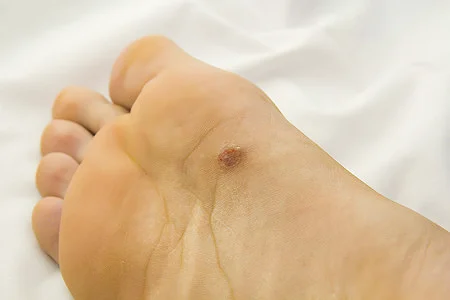Table of Contents
Introduction - Skin Cancer
Your feet and ankles are vulnerable to skin cancer – even the soles of your feet. Certain types of skin cancer are unrelated to sun exposure.
Types of Skin Cancer Found on the Foot and Ankle
There are 3 types of cancers found in the foot and ankle:
- Squamous Cell Carcinoma. These are the most common form in the feet and don’t spread in early stages. The growths can be itchy and may resemble a plantar wart, eczema, and ulcer or a fungal infection.
- Malignant Melanoma. Melanoma is one of the deadliest skin cancers and survival depends on early detection. A melanoma grows down into the skin and then can spread in the body through the lymphatic system and blood vessels. Melanomas can take many forms and may appear as a mole, ingrown toenail, bruise, plantar wart, ulcer or blood blister.
- Basal Cell Carcinoma. Because this cancer is usually caused by sun exposure, it is found on the feet less often. One of the least aggressive cancers, basal cell rarely spreads beyond the skin. They look like non-cancerous skin tumors or benign ulcers.
How To Spot Skin Cancer
To spot a melanoma, follow the ABCDs:
- Asymmetry where the two halves of a lesion don’t match
- Borders that are ragged or uneven
- Unusual colors like pink, red, black or blue, or more than one color
- A diameter wider than a pencil eraser
Treatment of Skin Cancer
A skin biopsy can confirm any suspicion of skin cancer.
If the biopsy is positive for skin cancer, your foot doctor will recommend the best course of treatment for your unique scenario.
Prevention of Skin Cancer on the Foot and Ankle
Limiting sun exposure for the feet and ankles can help prevent skin cancer. When you are outdoors, apply sunscreen of at least SPF 30 regularly, and don’t forget the soles of your feet when you are lying on the beach.
Examine your feet regularly for anything unusual. Check the bottoms and between the toes too. If you notice anything suspicious, schedule a visit with your podiatrist right away.



